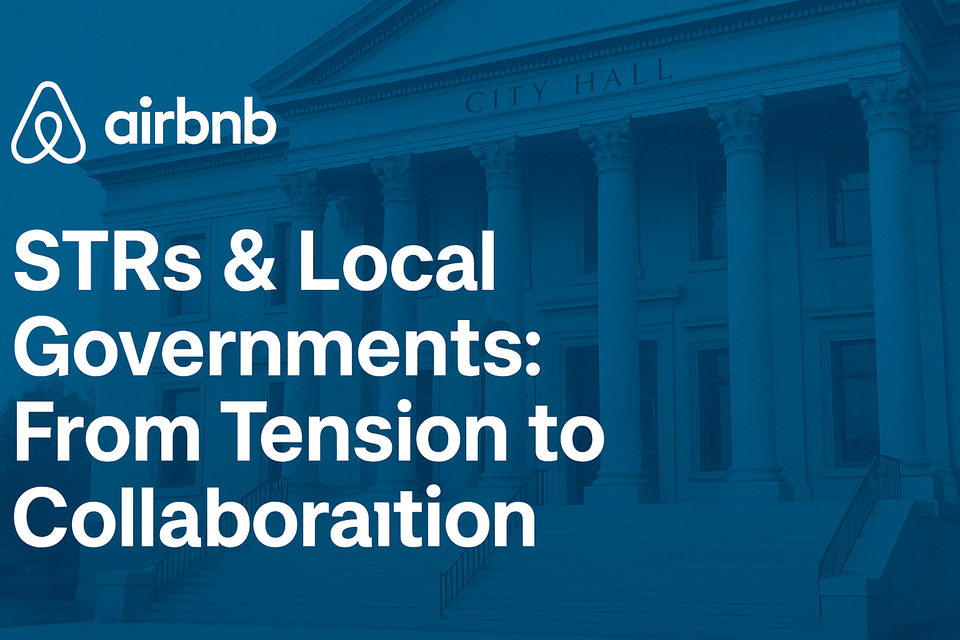STRs & Local Governments: From Tension to Collaboration

At a Glance:
- Cities often restrict STRs due to concerns about housing, noise, and community impact.
- Case studies show balanced policies can work: NYC vs Nashville vs Destin.
- STR owners can proactively engage with local governments to build trust.
- Learning to read and respond to ordinances is critical for compliance and profitability.
- Hosts who position STRs as partners in community growth will be the long-term winners.
This article contains affiliate links. If you click and purchase, we may earn a commission at no extra cost to you. As an Amazon Associate I earn from qualifying purchases.
Why STR Regulations Matter
If you’re a high-income W2 earner entering the short-term rental market, your first instinct might be to focus on ROI metrics—ADR, occupancy, and cash-on-cash return. But increasingly, local regulations are the make-or-break factor for STR profitability.
“The biggest risk in STR investing isn’t demand—it’s regulation.” – TheAirbnbDataGuy
Some cities are moving toward heavy restrictions, while others are embracing STRs as part of their economic engine. Understanding the spectrum is essential.
Common Local Concerns About STRs
- Noise & Parties: Late-night disruptions in residential areas.
- Parking & Congestion: Too many guests for the available infrastructure.
- Housing Affordability: Fear that STRs remove long-term housing stock.
- Waste & Cleanliness: Overflowing trash and lack of coordination with local schedules.
As Avery Carl, author of Short-Term Rental, Long-Term Wealth, puts it: “Communities push back when they feel STRs extract value without giving anything back.”
Real-World Examples of STR Regulations
| City/Market | Approach | Outcome |
|---|---|---|
| New York City (Local Law 18) | Requires hosts to register; bans rentals under 30 days unless owner-occupied. | Thousands of listings removed, underground STR economy persists. |
| Nashville, TN | Caps permits by district; differentiates between owner-occupied and non-owner STRs. | More balance, but caps limit scaling. |
| Destin, FL | Embraces STRs; requires tax registration and basic compliance. | Thriving STR economy integrated with local tourism. |
These three markets illustrate the spectrum: from restriction (NYC) to controlled compromise (Nashville) to integration (Destin).
How STR Owners Can Collaborate With Cities
1. Know Your Numbers
Show local leaders how much tax revenue your STR contributes. This strengthens your credibility. Tools like AirDNA (#ad) can provide data on market demand and occupancy trends.
2. Propose Practical Solutions
- Offer to use noise monitoring devices (non-invasive, decibel-only tools like NoiseAware).
- Share trash pickup schedules with guests or contract local services like Turno (#ad).
- Dedicate one parking spot for guests to reduce street congestion.
3. Build Relationships
Attend city council meetings. Many successful STR investors (including Avery Carl’s clients) report that simply showing up early—before a crisis—helps shift the narrative from “outsiders” to “stakeholders.”
How to Read an STR Ordinance in 10 Minutes
Step 1: Search “[Your City] short-term rental ordinance PDF.”
Step 2: Look for definitions (often at the top).
Step 3: Note restrictions by property type (primary vs secondary residence).
Step 4: Identify licensing/permit requirements.
Step 5: Scan for penalties (daily fines, revocation terms).
📌 Pro Tip: Keep a binder (digital or physical) of your STR permits and city notices. It shows professionalism if compliance is ever questioned.
Why Balanced Policies Work Best
Cities that strike a balance—like Austin, TX or Denver, CO—tend to:
- Collect more tourism tax revenue.
- Reduce friction with neighbors.
- Preserve housing stock while still encouraging investment.
By contrast, cities that overregulate (NYC, Honolulu) lose revenue and drive rentals underground, creating less oversight, not more.
Conclusion
For STR owners, navigating local government policies is as important as staging your property. By understanding the concerns, learning from real-world examples, and engaging proactively, you can position yourself as a community partner—not a threat.
This isn’t just compliance—it’s a long-term investment strategy.
See Also
- The STR Loophole Explained: How One Property Can Save You Six Figures in Taxes
- Top 7 Airbnb Upgrades That Boost ADR & Reviews
